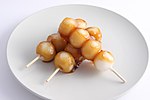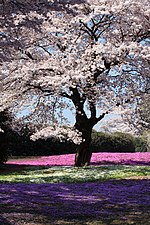Wagashi (和菓子, wa-gashi) is a traditional Japanese confection that is often served with green tea, especially the type made of mochi, anko (azuki bean...
31 KB (3,406 words) - 09:05, 4 June 2024
List of Japanese desserts and sweets (section Wagashi)
as a wagashi. The raindrop cake, created in 2014, was developed by a wagashi shop as a derivative of shingen mochi and is recognized as a wagashi in Japan...
14 KB (1,147 words) - 04:33, 18 June 2024
Raindrop cake is a wagashi (Japanese confection) made of water and agar that resembles a large raindrop. It first became popular in Japan in 2014 and...
8 KB (807 words) - 02:06, 26 June 2024
Taiyaki (category Wagashi)
song about taiyaki Wagashi, Japanese confectionery Harrison, Thom (19 April 2023). "Fish-shaped sweet street food". Wagashi UK. Wagashi UK. Retrieved 25...
6 KB (531 words) - 20:44, 2 June 2024
noodles, green tea ice cream, matcha lattes and a variety of Japanese wagashi confectionery. In Japan, labeling standards based on the Food Labeling...
49 KB (6,145 words) - 02:39, 24 June 2024
Momiji manjū is a type of wagashi that is baked. The confection is a buckwheat and rice cake shaped like a Japanese maple leaf, and is a local specialty...
3 KB (165 words) - 20:18, 11 April 2024
Daifuku (category Wagashi)
Daifukumochi (大福餅), or daifuku (大福) (literally "great luck"), is a wagashi, a type of Japanese confection, consisting of a small round mochi stuffed with...
5 KB (495 words) - 05:18, 19 June 2024
Yōkan (category Wagashi)
Yōkan (羊羹) is a wagashi (Japanese confection) made of red bean paste, agar, and sugar. It is usually sold in a block form, and eaten in slices. There...
5 KB (500 words) - 21:36, 19 June 2024
considered a specialty. Despite its foreign origins, it is considered a kind of wagashi, or traditional Japanese confectionery. To suit the tastes of Japanese...
10 KB (865 words) - 21:54, 25 June 2024
Warabimochi (category Wagashi)
Warabimochi (蕨餅, warabi-mochi) is a wagashi (Japanese confection) made from warabiko (bracken starch) and covered or dipped in kinako (sweet toasted soybean...
5 KB (554 words) - 09:22, 8 June 2024
Dango (category Wagashi)
called kushi-dango (串団子)). Generally, dango comes under the category of wagashi, and is often served with green tea. It is eaten year-round, but the different...
8 KB (782 words) - 00:21, 2 May 2024
widely used in Japanese cooking, but is strongly associated with dango and wagashi. Dango, dumplings made from mochiko (rice flour), are commonly coated with...
4 KB (328 words) - 22:10, 17 December 2023
dish, alongside ramen and sushi. Traditional Japanese sweets are known as wagashi. Ingredients such as red bean paste and mochi are used. More modern-day...
205 KB (16,676 words) - 00:52, 30 June 2024
Namagashi (category Wagashi)
Namagashi (生菓子) are a type of wagashi, which is a general term for traditional Japanese sweets and candies. Namagashi may contain fruit jellies, other...
2 KB (187 words) - 04:55, 10 April 2022
Gyūhi (category Wagashi)
Gyūhi (求肥) is a form of wagashi (traditional Japanese sweets). Gyūhi is a softer variety of mochi (餅), and both are made from either glutinous rice or...
2 KB (169 words) - 00:35, 21 May 2023
Shrine, a holy place founded in 994. The restaurant produces and sells wagashi, traditional Japanese confections often served with tea, namely: aburi-mochi...
2 KB (246 words) - 04:07, 2 December 2023
Hanabiramochi: a Japanese sweet (wagashi), usually eaten at the beginning of the year. Higashi: a type of wagashi, which is dry and contains very little...
47 KB (5,037 words) - 23:12, 25 June 2024
Monaka (category Wagashi)
landmarks, daruma, or other good luck symbols. Monaka is a type of dessert - wagashi - which is served with tea. There are still many very famous monaka specialty...
2 KB (190 words) - 13:16, 27 June 2024
traditional sakadane liquid yeast. He then filled the bread with a bean paste wagashi and sold the resulting rolls as snacks. Anpan became popular not only because...
4 KB (434 words) - 14:33, 10 June 2023
Anmitsu (category Wagashi)
Anmitsu (あんみつ, rarely 餡蜜) is a wagashi (Japanese dessert) that dates to the Meiji era. It is made of small cubes of agar jelly, a white translucent jelly...
2 KB (198 words) - 23:45, 21 March 2024
Higashi (food) (category Wagashi)
confectionery'), is a type of wagashi containing very little moisture, and thus keeps relatively longer than other kinds of wagashi. Higashi, in contrast to...
3 KB (282 words) - 04:55, 10 April 2022
with kuzuko) goma-dofu (kuzuko pudding with sesame paste) Examples of wagashi (Japanese desserts) with kuzuko: kuzukiri (clear cake of boiled kuzuko...
2 KB (191 words) - 10:12, 9 October 2023
Botamochi (category Wagashi)
Botamochi (ぼたもち or 牡丹餅) is a wagashi (Japanese confection) made with glutinous rice, white rice (ratio of 7:3, or only glutinous rice), and sweet azuki...
3 KB (351 words) - 10:12, 28 June 2023
Dorayaki (category Wagashi)
Dorayaki Alternative names Mikasa Type Wagashi pancake Place of origin Japan Main ingredients Castella, red bean paste or sweet azuki bean paste Media:...
5 KB (463 words) - 07:01, 19 May 2024
used as an ingredient in other prepared foods. Many types of traditional wagashi and mochigashi (Japanese traditional sweets) are made with mochi. For example...
49 KB (5,180 words) - 12:39, 29 June 2024
Gionbō (category Wagashi)
Gionbō (祇園坊 or ぎおんぼう) is a wagashi (Japanese sweet). It resembles a dried persimmon, and is now made by filling gyūhi (a soft form of mochi) with bean...
3 KB (252 words) - 14:23, 17 January 2024
Kusa mochi (category Wagashi)
during the spring Caozai guo, the Fujianese form "草餅の特徴・歴史・味 - 和菓子の季節.com". wagashi-season.com. Retrieved 2020-01-29. Ishihara, Masami (2017-03-04)....
4 KB (451 words) - 17:00, 19 March 2024
ingredient in many Japanese sweets. It is one of the ingredients used in making wagashi, and is eaten with kuzumochi, fruit, ice cream, and other confectionery...
2 KB (108 words) - 01:42, 6 June 2023
pickled in salt and umezu (ume vinegar), and used for coaxing out flavor in wagashi, a traditional Japanese confectionery, or anpan, a Japanese sweet bun most-commonly...
76 KB (7,612 words) - 16:40, 28 June 2024
Kibi dango (Okayama) (category Wagashi)
A Kibi dango (吉備団子, きびだんご, "Kibi Province dumpling"), is a type of wagashi sweet or snack with an eponymous reference to Kibi-no-kuni, an old province...
23 KB (2,864 words) - 00:09, 2 May 2024




























